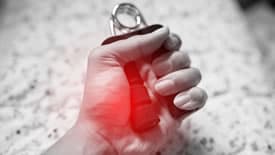Research team seeks to make blood pressure control easy

What if people could lower their blood pressure simply by squeezing their hands?
It may sound too good to be true, but a UNC Charlotte research team is producing some very promising results with isometric exercise – flexing muscles without moving a joint.
“Hypertension is a large problem, contributing to over 1,000 deaths per day in the U.S.,” said Reuben Howden, associate professor of kinesiology and member of the Laboratory of Systems Physiology. Howden leads a team of student researchers seeking a way to lower that risk. “Isometric exercise could become the first line of defense in preventing heart disease.”
According to the Centers for Disease Control, one-third of U.S. adults, or 75 million people, have high blood pressure and the increased risk of heart disease and stroke that comes with it. The UNC Charlotte research effort could help address that.
The specific exercise Howden refers to is called isometric handgrip exercise – squeezing those V-shaped spring-loaded devices one can pick up at the sporting goods store (although the researchers recommend using one with a digital readout to track workload, number of reps, etc.). Their work has shown that exercising each hand for only a few minutes (two to be exact), a few times per week can, over time, lower blood pressure by as much as 10 percent.
Howden has pursued the virtues of isometric exercise at UNC Charlotte since 2008. Prior to joining the University, he completed six years of post-doctoral work at the National Institute of Environmental Health Sciences.
The UNC Charlotte research project is one of a very small number in the United States. Other similar research efforts are underway in Canada, United Kingdom, Belgium, Australia and Brazil. Several studies have examined how this type of exercise works, but the answer to that question continues to elude.
In one recent study, past Master of Science in Kinesiology student Emily Zacherle and current graduate researcher Ben Gordon (biology and kinesiology) tracked participants ranging in age from 24 to 60 as they performed the handgrip exercises for 11 minutes per session, three days a week for 12 weeks. The study showed that not only did blood pressure decrease significantly; a checkup six weeks later suggested the benefits last for some time even after the exercise routine has ended.
The team now is focused on the effects of interventions on blood vessel function and inflammation, identifying factors responsible for lowering blood pressure in the long term. Gordon said they are still in the early stages of collecting data for this project, but “the results could really help point us in the right direction for identifying why people respond differently to these types of exercise programs.”
Try This at Home
In another study, conducted in collaboration with Jan Warren-Findlow, a faculty member in the Department of Public Health Sciences at UNC Charlotte, the researchers showed that the exercise was almost as effective when self-administered at home as in a group setting.
“We are still working on this, but if we are able to provide an effective intervention to a greater audience that can be completed in the person’s home, we are impacting many more people with hypertension, and that is a really good thing,” Gordon said.
The potential benefits of exercise for blood pressure management have been recognized for years. However, the physical exertion associated with traditional exercise routines is enough to scare many away.
“Isometric programs that incorporate larger muscle groups like the arms and legs can be difficult to do,” Gordon said. That difficulty led the team to focus on the hands. “Exercising with the smaller muscle group in the hand produces virtually the same blood pressure-lowering results as other whole body training programs.”
The handgrip exercise unit researchers use and recommend has digital readout so exercising workload (in kilograms) and number of repetitions can be measured and tracked. The units are available online and through department stores. The type of unit UNC Charlotte’s team recommends and has incorporated into both their on-campus and community- and clinic-based projects is a “Digital Handgrip Dynamometer.”
The isometric exercise blood pressure research is made possible in part by assistantships and fellowships for graduate students that are funded by the UNC Charlotte Graduate School. These grants can add thousands of dollars each year to help offset student expenses and afford students invaluable research and teaching experience.
In addition to his graduate assistantship, Gordon was a recipient of a 2017-18 Thomas L. Reynolds Graduate Student Research Award, which aided in offsetting costs of his current and final dissertation project. For more information on funding opportunities, visit How Graduate Student Funding Works.
Gordon served as a Graduate Life Fellow (GLF) in 2016. Through the University’s Center for Graduate Life, GLFs provide leadership-building opportunities, offer guidance and promote engagement to fellow students through first-hand experience, peer mentorship and graduate student events.
Photo: Reuben Howden